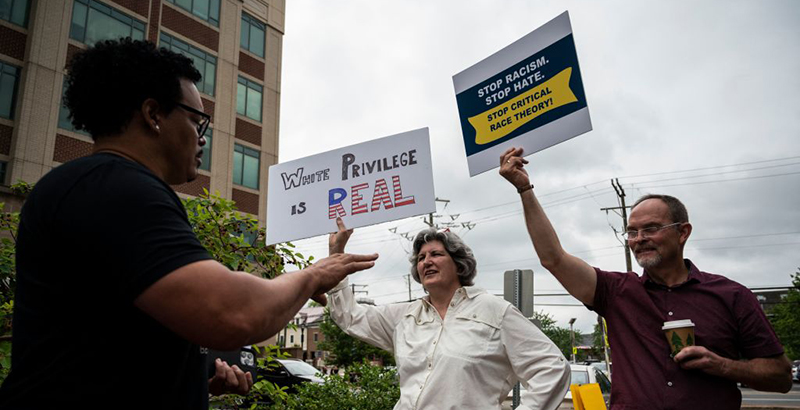New Research Points to ‘Loudoun County Effect’: When Parents Clash Over Ideology, Kids’ School Performance Suffers

Get stories like this delivered straight to your inbox. Sign up for The 74 Newsletter
Since the 2020 election, schools have emerged as some of the most contentious venues for American cultural discourse, with debates over the teaching of race, human sexuality, and U.S. history erupting into yelling matches and viral confrontations.
The political impact is increasingly seen in state and local elections, where school board members have faced a historic spate of recall attempts and gubernatorial candidates are familiarizing themselves with the tenets of critical race theory. But new research also suggests that adult disputes can have a measurable effect on how kids learn.
In a study of student test scores, a political scientist reveals damage to math achievement following high-profile controversies around cultural issues in school districts. Fairly modest on average, the effects resulting from debates specifically focused on race and evolution are somewhat larger, and they may result from the strain imposed on educators by enervating fights over competing values.
Study author Vlad Kogan, a professor at Ohio State University, informally referred to the phenomenon as the “Loudoun County effect” — a reference to the explosive strife that emerged last year in one of Virginia’s largest districts.
“Almost by definition, the more attention these [controversies] get, the less attention student learning receives,” said Kogan. “We could just be seeing the natural result of that: When adults are focused on other stuff, it’s the student learning that falls through the cracks.”

Opinion polling indicates that Americans are, on balance, satisfied with the performance of their local schools since the beginning of the pandemic. But public discontentment has also repeatedly flared around issues like the inclusion of trans athletes in girls’ athletics, while experts have simultaneously documented steep learning loss resulting from COVID-related school closures.
The study, which has not yet undergone peer review, examines the outcomes of specific episodes featured in the Public Schooling Battle Map, a publicly available inventory of culturally inflected disputes in K-12 schools. The database, maintained by the libertarian Cato Institute, details nearly 3,000 local controversies relating to “basic rights, moral values, or individual identities.” Those controversies appear in the Battle Map on the basis of local news coverage, and each case is grouped into one of nine broad categories, including sexuality, religion, race and ethnicity, and freedom of expression.
To assess the academic impact of those incidents, Kogan relied on math and English test score data provided by the Stanford Education Data Archive. A widely used research tool, SEDA allows comparisons between student performance in roughly 13,000 school districts around the country by indexing different state standardized test results to the National Assessment of Educational Progress.
In all, Kogan gathered a sample of approximately 520 local controversies between 2010 and 2018, dropping from the sample any districts that saw more than one controversy over that span and any larger-scale controversies likely to affect all districts within a state. He then compared the trajectory of their academic performance before and after the high-profile battles against a group of control districts that did not experience similar uproars.
The results were mixed: Compared with the control group, school districts that experienced cultural controversies did not see a drop in English scores measured between the third and eighth grades. But math scores among those students did decline in the aftermath of such controversies by an average of .018 standard deviations. (A “standard deviation” is the statistical unit most often used to measure effects in education research; an effect of that size would generally be considered small.)
In the context of the SEDA data — which finds that student math scores increase by an annual average .39 standard deviations between third and eighth grade — that relative downward movement accounts for about 5 percent of a full year’s growth in the subject.
Digging deeper into the results, Kogan also found that the overall math slippage following was driven overwhelmingly by cultural controversies in two of the nine Battle Map categories: race and human origins (including disagreements over the teaching of evolution versus intelligent design), for which the negative impact was three to four times larger. Students of different socioeconomic backgrounds were equally affected, meaning that the scale of local achievement gaps was unaltered by political fights.
Disquietingly, even if political attention dissipates, the apparent academic setbacks don’t disappear quickly. Math achievement still showed evidence of decline in the affected school districts even four years later.
Serotkin said it was “absolutely true” that his district had seen markedly higher attrition over the past two years, but argued that its cause couldn’t be known in an environment as chaotic as the pandemic.
“I have no idea whether that [turnover] is a result of the national political controversies that Loudoun has become a part of, or whether it’s just because of COVID.”
Dan Domenech, the longtime executive director of the American Association of School Superintendents, said that the most plausible cause for lower scores could simply be that a distracted local education establishment is necessarily a less effective one. Fractured goodwill and divided attention might lead to students getting the short end of the stick in terms of both oversight and learning resources.
“With functional school boards and administration, you can see that they’re providing teachers with the necessary materials — the technology, the books, the teacher training,” he argued. “The parallel to that on the negative side would be that if the board is in turmoil and involved in these culture wars, perhaps they’re not providing teachers with the resources that they need.”
Even so, Domenech pronounced himself skeptical of such a direct connection between controversy in school governance and results in the classroom.
“From a political point of view, I’d love to be able to say, ‘Stop your fighting — you’re affecting kids’ learning.’ It would be great to be able to say that, but they’re going to ask, ‘Well, how’s that happening?’ And that’s a question I’d have a hard time answering.”
Kogan conceded that the effects measured in the study are comparatively slight, but added that test scores themselves are only the clearest outward manifestation of how political strife affects teaching and learning.
“There’s probably other dimensions of the school environment that are really important to students but that we can’t measure through test scores. So in some ways, this is just the iceberg tip of the underlying dynamics in the districts. The fact that test scores are dropping in non-trivial amounts suggests that there are changes in how the districts are run that really filter down to the classroom level.”
Get stories like these delivered straight to your inbox. Sign up for The 74 Newsletter

;)
